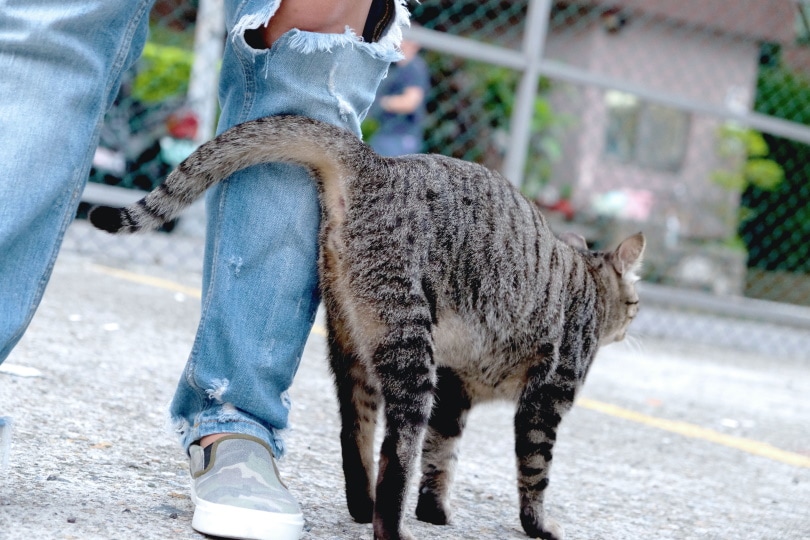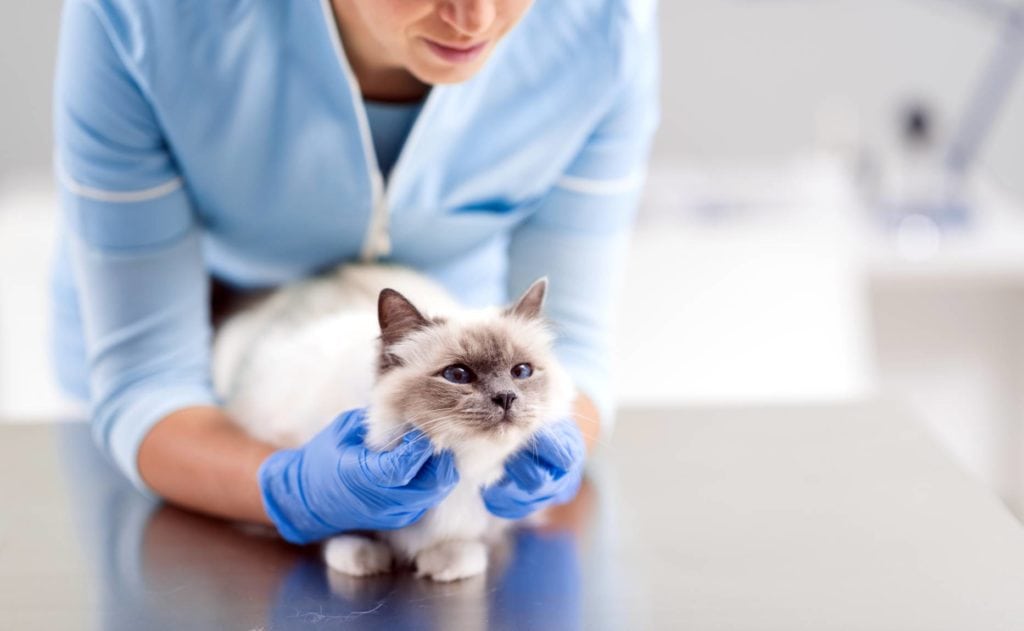
If you own a cat (or rather, are owned by one), you know how independent and stubborn they are. If your cat does have undesirable behaviors, you might believe that you’re stuck with them. But while the idea of teaching or training your cat might at first seem like an impossible task, you know how intelligent they are, so it’s not all that far-fetched.
Sometimes, training them is for their own good and not just because your cat loves to knock breakable items onto the floor. Some cats bite on electrical wires or are aggressive with you or other members of the household. Here, we look at the best techniques that you can use to help prevent your cat from continuing to do these naughty (or dangerous) things.
The 14 Methods & Tips for Disciplining Your Cat

The 3 Positive Reinforcement Tips
The first thing that you need to do is figure out the best way to reward your cat—what you think your cat will best respond to. If your cat is food motivated, use a favorite treat during training sessions. If your cat loves a good cheek scratch or has a preferred toy, use affection or play as a reward.
Use whatever you know that your cat will respond best to but only when teaching your cat about stopping the bad behavior. This way, your cat will start to associate this special treat/toy when eliminating this specific behavior.
This can also work well if you use a new treat that your cat isn’t familiar with, such as a new (and fresh) catnip toy, canned tuna, or a new feather toy. If your cat loves tuna, there will be a great deal of motivation for them to do what you want for a taste of it!
1. Reward Good Behavior
Almost every living thing responds to rewards more than punishment. When your cat stops doing the behavior or when they do the behavior that you prefer (such as scratching the scratching post instead of your favorite chair), give your cat their special treat or some pets and attention.
Eventually, your cat will start to recognize that good things happen when they stop the bad behavior or when they are doing specific actions that you obviously prefer.
2. Don’t Give Them Attention After Bad Behavior
If the bad behavior is aggressive, such as biting or playing too roughly, you should withdraw your attention and yourself from the situation. When they are kittens, they learn from their siblings about how not to play rough. If a kitten bites too hard while playing, the other kitten will yelp and immediately stop playing, so the first kitten learns what is appropriate play and what is too rough.
You can use this strategy with your cat. If you stop playing with or petting your cat when they exhibit an unwanted behavior, you’re taking away your attention and consequently, your cat’s fun. This eventually can discourage your cat from continuing this behavior. Any form of attention from you can be perceived as a further invitation from you to continue to play.
3. Redirect Your Cat
When your cat starts the behavior that you want to stop, you can redirect or distract your cat at that time. For example, when your cat starts to scratch your couch, pick up a feather wand or toss one of your cat’s toys (a mouse or a spring, for example), which should effectively draw your cat immediately away from continuing the destructive behavior.
The 5 Methods for Discouraging Bad Behaviors
Cats will not respond well (or at all) if they are punished, so there are several tricks that you can use to help discourage their naughty behavior.
1. Scent
There are many scents that cats dislike, particularly citrus, and you can spray these on areas where your cat is causing problems. Your cat will naturally avoid this area. You can buy them online or make your own. However, be aware that essential oils (commonly used for scents) are quite toxic for cats, so do your research.
2. Cord Wrap
If your cat is in the habit of chewing on electrical wires and cords, you can purchase cord wraps that will prevent your cat from biting through. Some cord wraps also come with a deterrent scent for your cat, but you’ll end up having to smell it too.
3. Sudden Noise
A sudden loud noise can startle cats, and they will take off in a hurry. You can try clapping your hands, but this isn’t always effective. You can use a bottle, jar, or can filled with dried beans, coins, rocks, or whatever you have on hand. Give it a quick shake when your cat jumps on the counter, and they’ll bolt.

4. Texture
If your cat is scratching a door frame or walking on your dining room table, you can place aluminum foil or double-sided tape on these surfaces. Cats don’t enjoy the feel or noise of the aluminum foil, and they don’t like when their paws touch anything sticky, so they will avoid any area with these deterrents.
You can also place silky-like material on your leather couch so your cat won’t be able to scratch, or you can place a baking sheet on the edge of the counter that your cat always jumps up on. This way, it will fall down when your cat jumps up, and they might think twice about jumping on that counter again.
5. Vocalization
When your cat bites too hard or is more aggressive than comfortable, you can use the startle method but with your voice. Yell, “Ouch!” and completely stop any interaction that you are having with your cat. This is like the kitten that yelps and stops playing when play becomes too rough.
There are products that use a combination of a sudden loud noise and a pheromone scent designed to calm cats down, which helps stop unwanted behaviors.

The 6 Things You Shouldn’t Do
There are several actions that you should not do because they will end up causing more harm than good.
1. Don’t Forget That Cats Are Not Dogs
Cats are not dogs. They cannot be trained or disciplined the same way that you would train a dog. While most dogs will pay attention during training, most cats will not. Just knowing that cats are unique and need to be approached differently is an ideal way to first address the problem.

2. Don’t Use Physical Punishment
This should be obvious: Physically harming an animal at any time is not okay. Your cat will not learn from it and will only fear you, and the behavior will probably worsen. You’ll lose your bond with your cat, so never hit or shake your cat, no matter how frustrated you feel.
In fact, like most animals, they don’t associate the punishment with the bad behavior, so it’s ineffective at best!
3. Don’t Yell
You shouldn’t yell at your cat. This is different from yelling out a brief, “Ouch!” when your cat is playing too rough. Yelling at your cat out of anger won’t do anything except cause your cat to feel anxious and stressed, which can then lead to more behavioral problems.

4. Don’t Forget That Accidents Will Happen
If your cat ever pees or poops outside of the litter box, don’t ever rub your cat’s nose in it. As smart as cats are, they won’t understand why you’re doing this and will continue going outside of the litter box.
When it happens, clean up the mess using an enzyme cleaner so your cat won’t be attracted to that location again.
5. Don’t Scruff Your Cat
Scruffing a cat is something that should only be done if it’s for you or your cat’s safety. Grabbing cats by the scruff of their neck is painful for them and can cause fear and anxiety. Instead, put a blanket over your cat, and pick it up with your cat still inside. This is the better mode of moving your cat if you need to quickly remove them from a situation.
6. Don’t Forget to Check If It Is a Health Problem
Sometimes the bad behavior might be due to other issues, such as illness. If the bad behavior is your cat urinating outside of the litter box, for example, check with your vet before assuming your cat is just being naughty.

Conclusion
Not every technique will work for every cat. You might need to go through a bit of trial and error before you land on what will work most effectively for your cat.
If you’re going to use a form of deterrent for your cat, try to use something that your cat will not associate with you. It’s best to set up “booby traps,” so your cat will associate something unpleasant (texture or sound) with that area rather than you.
We hope that these tips will help you and your cat. More than anything, make sure whatever you try, it’s safe for your cat and doesn’t cause any kind of rift between you two.
You may also want to read:
Featured Image Credit: Piqsels






